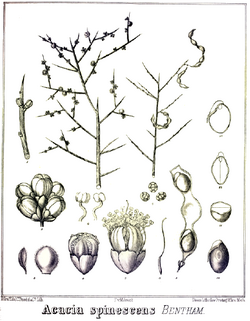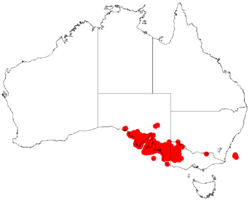Biology:Acacia spinescens
| Spiny wattle | |
|---|---|

| |
| Sketches of Acacia spinescens from Iconography of Australian species of Acacia and cognate genera | |
| Scientific classification | |
| Kingdom: | Plantae |
| Clade: | Tracheophytes |
| Clade: | Angiosperms |
| Clade: | Eudicots |
| Clade: | Rosids |
| Order: | Fabales |
| Family: | Fabaceae |
| Subfamily: | Caesalpinioideae |
| Clade: | Mimosoid clade |
| Genus: | Acacia |
| Species: | A. spinescens
|
| Binomial name | |
| Acacia spinescens Benth.
| |

| |
| Occurrence data from AVH | |
Acacia spinescens, commonly known as spiny wattle,[1] is a shrub belonging to the genus Acacia and the subgenus Alatae. It is native to New South Wales, South Australia and Victoria.[2]
Description
The erect multi-branched shrub typically grows to a height of around 0.5 to 1 metre (2 to 3 ft).[3] The rigid terete branchlets are green and spiny with yellow rib striations. The usually will have few or no leaves with sometimes remaining at the base of the plant. The leaves have a curved or hooked shape with a prominent mid-vein. It flowers between July and October producing a solitary flower-spike solitary with bright yellow, globular flower-heads. It will later form dark brown seed pods with a curving and often twisted linear shape. Each pod is around 30 millimetres (1.2 in) in length with a width of 3.5 mm (0.1 in). Pods contain hard, dark brown seeds with an ovoid shape. Each seed is around 3.5 mm (0.1 in) long and 2.5 mm (0.1 in) wide.[1]
Classification
The species name is taken from the Latin words spina meaning thorn or spine and escens meaning beginning. The name refers to the branches ending with a sharp point or spine.[1] The species was named by George Bentham in 1842 as part of the William Jackson Hooker work Notes on Mimoseae, with a synopsis of species published in the London Journal of Botany.[4]
Distribution
The species is found in a variety of soil types and ecological communities and associates with other plant species. In South Australia it is found in southern parts extending from the Great Victoria Desert in the west through to the border with Victoria in the east . It is also found on Kangaroo Island.[1] In Victoria the plant is only found in eastern areas in the mallee and goldfields regions extending north into south-western parts of New South Wales.[3]
See also
References
- ↑ 1.0 1.1 1.2 1.3 "Acacia spinescens (Leguminosae) Spiny Wattle". Seeds of South Australia. Government of South Australia. http://saseedbank.com.au/species_information.php?rid=226.
- ↑ "Acacia spinescens Benth.". Atlas of Living Australia. Global Biodiversity Information Facility. http://bie.ala.org.au/species/urn:lsid:biodiversity.org.au:apni.taxon:302113.
- ↑ 3.0 3.1 "Acacia spinescens Benth. Spiny Wattle". Flora of Victoria. Royal Botanic Gardens Victoria. https://vicflora.rbg.vic.gov.au/flora/taxon/1d7d3723-2673-456d-9a9f-a6e48dc72958.
- ↑ "Acacia spinescens Benth.". Atlas of Living Australia. Global Biodiversity Information Facility. http://bie.ala.org.au/species/http://id.biodiversity.org.au/node/apni/2907359#names.
Wikidata ☰ Q9569367 entry
 |

